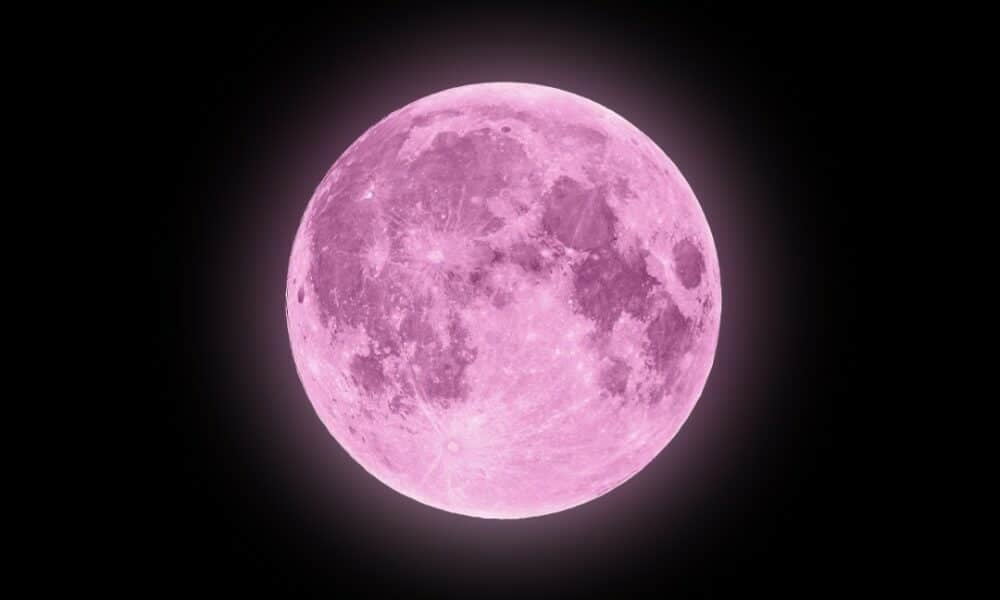This Saturday, April 12, the night sky over Brazil will host a celestial marvel: the Pink Moon, the first full moon of spring in the Northern Hemisphere, rising at approximately 8:30 p.m. Brasília time. Visible to the naked eye across the country, the event promises to captivate astronomy enthusiasts and casual stargazers alike, provided clear skies prevail without heavy clouds or rain. Contrary to its name, the Pink Moon won’t glow pink but will shine brilliantly, illuminating the night until dawn.
The phenomenon occurs when Earth aligns between the Sun and the Moon, allowing the satellite to reflect sunlight fully. Observers in Brazil can watch the Moon rise in the east during twilight, remaining visible until it sets in the west at sunrise on Sunday. For those eager to capture the moment, telescopes or even smartphones with decent zoom can reveal striking details, particularly in areas with minimal light pollution.
In cities like São Paulo, Rio de Janeiro, and Brasília, astronomy clubs are organizing group viewings, bringing together beginners and experts. These gatherings provide access to high-powered telescopes and guidance on spotting nearby constellations. For those staying home, online platforms like YouTube offer live streams of the event, showcasing the Moon through professional observatories worldwide.
- Tips for viewing the Pink Moon in Brazil:
- Choose elevated spots like hills or rooftops to avoid horizon obstructions.
- Check weather forecasts to ensure clear skies in your area.
- Use astronomy apps like Stellarium or SkySafari to pinpoint the Moon accurately.
The story behind the Pink Moon
The name Pink Moon sparks intrigue, but its roots lie more in earthly traditions than celestial hues. In the United States, it refers to the blooming of Phlox subulata, or Moss Pink, a wildflower with vibrant pink petals that carpets the ground in eastern North America during spring. Indigenous cultures named each full moon based on seasonal events, and the Pink Moon became synonymous with spring’s renewal.
While the Moon may occasionally appear reddish due to atmospheric particles like volcanic dust or pollution, such a tint is rare for April’s full moon. In 2025, the Pink Moon will be a microluna, meaning it’s farther from Earth than a supermoon, appearing slightly smaller in the sky. Still, its radiance will be no less mesmerizing, especially in rural areas where artificial lights don’t dim the view.
A milestone in the lunar calendar
The Pink Moon holds cultural and religious significance across the globe. In Christianity, it’s known as the Paschal Moon, setting the date for Easter, which falls on the first Sunday after the first full moon of spring in the Northern Hemisphere. In 2025, Easter will be celebrated on April 20, a week after the Pink Moon, highlighting its role in religious traditions.
The event also kicks off a series of full moons that track seasonal shifts throughout the year. Each full moon carries a unique name, such as the Flower Moon in May or the Hunter’s Moon in October, blending astronomy with folklore. For Native American tribes, these names guided activities like planting, harvesting, and hunting, tying the sky to daily life.
In Brazil, the Pink Moon inspires cultural activities. In cities like Florianópolis and Recife, astronomy groups host lectures and night photography sessions, engaging the public with the event’s visibility. Schools and planetariums, such as São Paulo’s, arrange educational programs, teaching students about celestial movements and the value of preserving dark skies.
Preparing for the Pink Moon
Planning your Pink Moon observation can elevate the experience to something unforgettable. In urban areas, light pollution may pose a challenge, but parks or squares away from city centers offer better views. In Brazil’s countryside, towns like Campos do Jordão in São Paulo or Gonçalves in Minas Gerais are popular among amateur astronomers for their clear skies and low light interference.
Basic equipment like binoculars can reveal lunar surface details, such as craters and maria—dark plains formed by ancient lava flows. For those interested in telescopes, entry-level models with 70 mm lenses are ideal for beginners. Mobile apps also assist in mapping the sky, showing the Moon’s exact position alongside nearby stars.
Timing matters too. The Moon’s rise around 8:30 p.m. is perfect for photography, as it appears larger near the horizon due to an optical effect called the lunar illusion. As the night progresses, the Moon climbs higher, making details easier to spot. In coastal cities like Salvador or Fortaleza, the Moon’s reflection on the sea creates breathtaking scenes.
- Top spots for Pink Moon viewing in Brazil:
- Pico do Jaraguá, São Paulo: the city’s highest point with a wide horizon view.
- Pipa Beach, Rio Grande do Norte: clear skies and natural beauty.
- Serra da Canastra National Park, Minas Gerais: perfect for remote, starry skies.
Lunar events in 2025
The Pink Moon is just the start of a stellar lineup for 2025. In May, the Flower Moon will shine brightly, followed by the Strawberry Moon in June and the Thunder Moon in July. Each offers a chance to connect with the cosmos and learn about the universe.
Beyond full moons, the year includes other highlights. A total lunar eclipse on March 14 will be partially visible in Brazil, with another in September offering better views in the Northeast. These events draw crowds to observatories and planetariums, where professional telescopes unveil the Moon’s intricate details.
For lunar enthusiasts, 2025 features 12 full moons, one per month, plus meteor showers and planetary alignments. Astronomers advise marking calendars and planning observations in advance, especially in areas with low light pollution.
Cultural impact of the Pink Moon
The Pink Moon resonates beyond astronomy, shaping traditions and artistic expressions. In Brazil’s indigenous communities, like the Guarani, full moons symbolize renewal and harmony with nature. Ceremonies often align with these phases, strengthening cultural and spiritual bonds.
In urban settings, the Pink Moon inspires photographers and artists. Exhibitions in cities like Curitiba and Belo Horizonte showcase images of the event, often pairing the Moon with landmarks like Rio’s Sugarloaf Mountain or São Paulo’s Estaiada Bridge.
Music also captures the Moon’s allure. Independent bands and cultural festivals host open-air concerts during the event, creating magical moments under the moonlight. In 2025, events like Porto Alegre’s Full Moon Festival plan to celebrate with live music and astronomy workshops.
Fascinating facts about the Pink Moon
Delving into the Pink Moon reveals intriguing details that enhance the viewing experience. While its name ties to earthly traditions, its astronomical significance remains profound.
- Pink Moon trivia:
- The term “Pink Moon” first appeared in 18th-century American almanacs.
- April’s microluna will be about 406,000 kilometers from Earth, farther than a supermoon.
- In some Asian cultures, April’s full moon sparks lantern festivals.
- The Pink Moon influences religious calendars in Judaism and Islam.
Astronomy for everyone
The Pink Moon opens doors to astronomy for all. In Brazil, initiatives like the Sky for All project in São Luís bring telescopes to underserved communities, letting kids and adults explore the stars. Public schools incorporate the event into science lessons, using tools like star charts to teach about the solar system.
Astronomy clubs, such as Minas Gerais’ Center for Astronomical Studies, offer free courses and open viewing sessions. These efforts show that expensive gear isn’t necessary—a pair of binoculars or a curious gaze can spark a lifelong passion for the cosmos.
Social media amplifies this enthusiasm. Amateur astronomers share Pink Moon tips and photos, encouraging broader participation. In 2025, event-related hashtags are expected to trend on platforms like Instagram and Twitter, uniting stargazers globally.
2025 lunar calendar
Tracking lunar events helps plan observations and understand celestial rhythms. The Pink Moon launches 2025’s full moon cycle, each with distinct traits.
- Key full moons of 2025:
- Flower Moon: May 12, tied to spring’s peak in the Northern Hemisphere.
- Strawberry Moon: June 11, linked to fruit harvests in the U.S.
- Thunder Moon: July 10, named for seasonal storms.
- Sturgeon Moon: August 9, connected to lake fishing in North America.

Technology and lunar observation
Technology transforms how we experience the Pink Moon. Modern telescopes with high-resolution cameras capture detailed images of the lunar surface, revealing mountains and craters formed billions of years ago. Observatories like Pico dos Dias in Minas Gerais share these visuals with the public, bridging science and society.
For those without advanced tools, smartphones with strong cameras are a great alternative. Photo-editing apps enhance brightness and contrast, highlighting subtle details. Live-streaming platforms also broadcast the event, with astronomers narrating each phase in real time.
Artificial intelligence further democratizes astronomy. Apps like Google Sky and Star Walk use AI to identify celestial bodies instantly, guiding novices through the night sky. These tools make the Pink Moon accessible to everyone, fueling interest in science.
The future of lunar observation
The 2025 Pink Moon arrives amid growing excitement about space exploration. NASA’s Artemis program aims to return humans to the Moon soon, reigniting fascination with our closest neighbor. In Brazil, startups like Pion Labs signal a bright future for national astronomy.
The event also boosts astro-tourism. Destinations like Chile’s Atacama Desert and Bahia’s interior draw visitors seeking pristine skies. In Brazil, efforts to create dark sky reserves—areas shielded from light pollution—are gaining traction among environmentalists and astronomers.
The Pink Moon is more than a fleeting spectacle. It connects people to the universe, inspires future scientists, and underscores the need to protect our planet and its skies.

This Saturday, April 12, the night sky over Brazil will host a celestial marvel: the Pink Moon, the first full moon of spring in the Northern Hemisphere, rising at approximately 8:30 p.m. Brasília time. Visible to the naked eye across the country, the event promises to captivate astronomy enthusiasts and casual stargazers alike, provided clear skies prevail without heavy clouds or rain. Contrary to its name, the Pink Moon won’t glow pink but will shine brilliantly, illuminating the night until dawn.
The phenomenon occurs when Earth aligns between the Sun and the Moon, allowing the satellite to reflect sunlight fully. Observers in Brazil can watch the Moon rise in the east during twilight, remaining visible until it sets in the west at sunrise on Sunday. For those eager to capture the moment, telescopes or even smartphones with decent zoom can reveal striking details, particularly in areas with minimal light pollution.
In cities like São Paulo, Rio de Janeiro, and Brasília, astronomy clubs are organizing group viewings, bringing together beginners and experts. These gatherings provide access to high-powered telescopes and guidance on spotting nearby constellations. For those staying home, online platforms like YouTube offer live streams of the event, showcasing the Moon through professional observatories worldwide.
- Tips for viewing the Pink Moon in Brazil:
- Choose elevated spots like hills or rooftops to avoid horizon obstructions.
- Check weather forecasts to ensure clear skies in your area.
- Use astronomy apps like Stellarium or SkySafari to pinpoint the Moon accurately.
The story behind the Pink Moon
The name Pink Moon sparks intrigue, but its roots lie more in earthly traditions than celestial hues. In the United States, it refers to the blooming of Phlox subulata, or Moss Pink, a wildflower with vibrant pink petals that carpets the ground in eastern North America during spring. Indigenous cultures named each full moon based on seasonal events, and the Pink Moon became synonymous with spring’s renewal.
While the Moon may occasionally appear reddish due to atmospheric particles like volcanic dust or pollution, such a tint is rare for April’s full moon. In 2025, the Pink Moon will be a microluna, meaning it’s farther from Earth than a supermoon, appearing slightly smaller in the sky. Still, its radiance will be no less mesmerizing, especially in rural areas where artificial lights don’t dim the view.
A milestone in the lunar calendar
The Pink Moon holds cultural and religious significance across the globe. In Christianity, it’s known as the Paschal Moon, setting the date for Easter, which falls on the first Sunday after the first full moon of spring in the Northern Hemisphere. In 2025, Easter will be celebrated on April 20, a week after the Pink Moon, highlighting its role in religious traditions.
The event also kicks off a series of full moons that track seasonal shifts throughout the year. Each full moon carries a unique name, such as the Flower Moon in May or the Hunter’s Moon in October, blending astronomy with folklore. For Native American tribes, these names guided activities like planting, harvesting, and hunting, tying the sky to daily life.
In Brazil, the Pink Moon inspires cultural activities. In cities like Florianópolis and Recife, astronomy groups host lectures and night photography sessions, engaging the public with the event’s visibility. Schools and planetariums, such as São Paulo’s, arrange educational programs, teaching students about celestial movements and the value of preserving dark skies.
Preparing for the Pink Moon
Planning your Pink Moon observation can elevate the experience to something unforgettable. In urban areas, light pollution may pose a challenge, but parks or squares away from city centers offer better views. In Brazil’s countryside, towns like Campos do Jordão in São Paulo or Gonçalves in Minas Gerais are popular among amateur astronomers for their clear skies and low light interference.
Basic equipment like binoculars can reveal lunar surface details, such as craters and maria—dark plains formed by ancient lava flows. For those interested in telescopes, entry-level models with 70 mm lenses are ideal for beginners. Mobile apps also assist in mapping the sky, showing the Moon’s exact position alongside nearby stars.
Timing matters too. The Moon’s rise around 8:30 p.m. is perfect for photography, as it appears larger near the horizon due to an optical effect called the lunar illusion. As the night progresses, the Moon climbs higher, making details easier to spot. In coastal cities like Salvador or Fortaleza, the Moon’s reflection on the sea creates breathtaking scenes.
- Top spots for Pink Moon viewing in Brazil:
- Pico do Jaraguá, São Paulo: the city’s highest point with a wide horizon view.
- Pipa Beach, Rio Grande do Norte: clear skies and natural beauty.
- Serra da Canastra National Park, Minas Gerais: perfect for remote, starry skies.
Lunar events in 2025
The Pink Moon is just the start of a stellar lineup for 2025. In May, the Flower Moon will shine brightly, followed by the Strawberry Moon in June and the Thunder Moon in July. Each offers a chance to connect with the cosmos and learn about the universe.
Beyond full moons, the year includes other highlights. A total lunar eclipse on March 14 will be partially visible in Brazil, with another in September offering better views in the Northeast. These events draw crowds to observatories and planetariums, where professional telescopes unveil the Moon’s intricate details.
For lunar enthusiasts, 2025 features 12 full moons, one per month, plus meteor showers and planetary alignments. Astronomers advise marking calendars and planning observations in advance, especially in areas with low light pollution.
Cultural impact of the Pink Moon
The Pink Moon resonates beyond astronomy, shaping traditions and artistic expressions. In Brazil’s indigenous communities, like the Guarani, full moons symbolize renewal and harmony with nature. Ceremonies often align with these phases, strengthening cultural and spiritual bonds.
In urban settings, the Pink Moon inspires photographers and artists. Exhibitions in cities like Curitiba and Belo Horizonte showcase images of the event, often pairing the Moon with landmarks like Rio’s Sugarloaf Mountain or São Paulo’s Estaiada Bridge.
Music also captures the Moon’s allure. Independent bands and cultural festivals host open-air concerts during the event, creating magical moments under the moonlight. In 2025, events like Porto Alegre’s Full Moon Festival plan to celebrate with live music and astronomy workshops.
Fascinating facts about the Pink Moon
Delving into the Pink Moon reveals intriguing details that enhance the viewing experience. While its name ties to earthly traditions, its astronomical significance remains profound.
- Pink Moon trivia:
- The term “Pink Moon” first appeared in 18th-century American almanacs.
- April’s microluna will be about 406,000 kilometers from Earth, farther than a supermoon.
- In some Asian cultures, April’s full moon sparks lantern festivals.
- The Pink Moon influences religious calendars in Judaism and Islam.
Astronomy for everyone
The Pink Moon opens doors to astronomy for all. In Brazil, initiatives like the Sky for All project in São Luís bring telescopes to underserved communities, letting kids and adults explore the stars. Public schools incorporate the event into science lessons, using tools like star charts to teach about the solar system.
Astronomy clubs, such as Minas Gerais’ Center for Astronomical Studies, offer free courses and open viewing sessions. These efforts show that expensive gear isn’t necessary—a pair of binoculars or a curious gaze can spark a lifelong passion for the cosmos.
Social media amplifies this enthusiasm. Amateur astronomers share Pink Moon tips and photos, encouraging broader participation. In 2025, event-related hashtags are expected to trend on platforms like Instagram and Twitter, uniting stargazers globally.
2025 lunar calendar
Tracking lunar events helps plan observations and understand celestial rhythms. The Pink Moon launches 2025’s full moon cycle, each with distinct traits.
- Key full moons of 2025:
- Flower Moon: May 12, tied to spring’s peak in the Northern Hemisphere.
- Strawberry Moon: June 11, linked to fruit harvests in the U.S.
- Thunder Moon: July 10, named for seasonal storms.
- Sturgeon Moon: August 9, connected to lake fishing in North America.

Technology and lunar observation
Technology transforms how we experience the Pink Moon. Modern telescopes with high-resolution cameras capture detailed images of the lunar surface, revealing mountains and craters formed billions of years ago. Observatories like Pico dos Dias in Minas Gerais share these visuals with the public, bridging science and society.
For those without advanced tools, smartphones with strong cameras are a great alternative. Photo-editing apps enhance brightness and contrast, highlighting subtle details. Live-streaming platforms also broadcast the event, with astronomers narrating each phase in real time.
Artificial intelligence further democratizes astronomy. Apps like Google Sky and Star Walk use AI to identify celestial bodies instantly, guiding novices through the night sky. These tools make the Pink Moon accessible to everyone, fueling interest in science.
The future of lunar observation
The 2025 Pink Moon arrives amid growing excitement about space exploration. NASA’s Artemis program aims to return humans to the Moon soon, reigniting fascination with our closest neighbor. In Brazil, startups like Pion Labs signal a bright future for national astronomy.
The event also boosts astro-tourism. Destinations like Chile’s Atacama Desert and Bahia’s interior draw visitors seeking pristine skies. In Brazil, efforts to create dark sky reserves—areas shielded from light pollution—are gaining traction among environmentalists and astronomers.
The Pink Moon is more than a fleeting spectacle. It connects people to the universe, inspires future scientists, and underscores the need to protect our planet and its skies.







